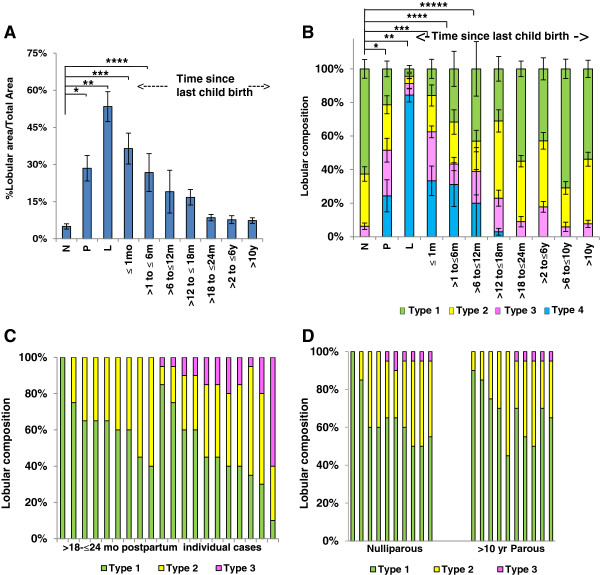Figure 3.

Histological evidence of postpartum involution in human breast. A. Percent lobular area by reproductive groups of nulliparous (N) (n = 12), pregnant (P) (n = 15), lactation (L) (n = 8), up to 1 (n = 6), >1 to ≤6 (n = 9), >6 to ≤12 (n = 5), >12 to ≤18 (n = 5), >18 to ≤24 months (n = 12), >2 to ≤6 years (n = 11) and >10 years (n = 10) since last child birth. Percent lobular area is significantly different from N during P (*P <0.0001), L (**P <0.0001), ≤1 (***P <0.0001), and at >1 to ≤6 months (****P = 0.0007) postpartum, and not statistically different at 12 months postpartum (P = 0.07). B. Breast lobular composition across the reproductive groups of N (n = 23), P (n = 16), L (n = 8), up to 1 (n = 6), >1 to ≤6 (n = 9), >6 to ≤12 (n = 5), >12 to ≤18 (n = 5), >18 to ≤24 months (n = 20), and >2 to ≤6 (n = 24), >6 to ≤10 (n = 10) and >10 years (n = 25) since last child birth. The lobular type composition is different from the N group during P (*P <0.001), L (**P <0.001), ≤1 month (***P <0.0001), >1 to ≤6 months (****P = 0.0001), >6 to ≤12 months (*****P = 0.001) postpartum, and is indistinguishable by 18 months postpartum (P = 0.08). C. Lobular composition of individual women who are >18 to ≤24 months postpartum (n = 20). D. An independent Norwegian cohort comprising Nulliparous (n = 10) and >10 years parous (n = 10) cases shows no lobular differences between groups. Type 1 (P = 0.72), 2 (P = 0.81) and 3 (P = 0.47). All error bars represent standard error of the mean (SEM).
